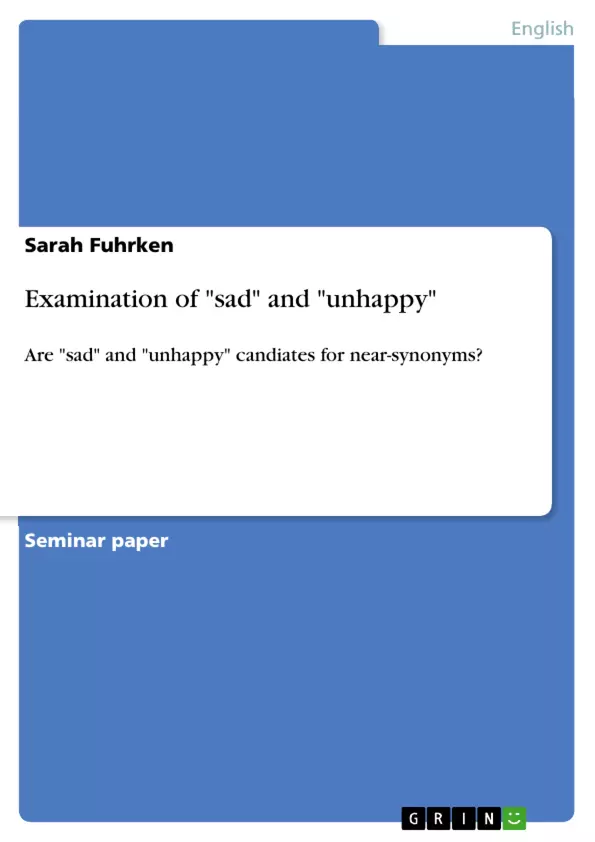This document examines the differences and similarities of the words <sad> and <unhappy>.
For examination, the Longman Dictionary of Contemporary English and the British National Corpus are used.
Collocations and colligations are also considered and tables are included.
Table of Contents
- Examination of sad and unhappy
- Longman Dictionary of Contemporary English
- British National Corpus
- Context in which sad and unhappy occur
- Collocations of sad and unhappy
- Table 1: 10 strongest noun-collocations of sad and unhappy
- Table 2: 10 strongest verb-collocations of sad and unhappy
- Table 3: 10 strongest adverb-collocations of sad and unhappy
- Colligation of sad and unhappy
- Conclusion
Objectives and Key Themes
The main objective of this text is to investigate whether the words "sad" and "unhappy" can be considered near-synonyms. This is done through an examination of their definitions in a dictionary, their frequency and context of use in a large corpus of English text (the British National Corpus), their collocations (words frequently appearing with them), and their colligations (grammatical behavior).
- Comparative analysis of the definitions of "sad" and "unhappy".
- Frequency and contextual usage of "sad" and "unhappy" in the British National Corpus.
- Examination of collocations for "sad" and "unhappy" with nouns, verbs, and adverbs.
- Analysis of the grammatical behavior (colligation) of "sad" and "unhappy".
- Determination of the degree of synonymy between "sad" and "unhappy".
Chapter Summaries
Examination of sad and unhappy: This introductory section poses the central question of whether "sad" and "unhappy" are near-synonyms, setting the stage for the subsequent analysis using various linguistic methods. It establishes the core research question that will drive the investigation throughout the text. The groundwork is laid for a detailed examination of the two words through different lenses, including dictionary definitions and corpus analysis.
Longman Dictionary of Contemporary English: This section analyzes the definitions of "sad" and "unhappy" provided by the Longman Dictionary of Contemporary English. It highlights the similarities and differences in their definitions, noting that while both relate to feelings of unhappiness, "sad" encompasses a broader range of meanings including loneliness and dissatisfaction, while "unhappy" is more narrowly defined as lacking happiness or being worried. This sets the stage for the further investigation in the later sections, focusing specifically on the nuances between these terms.
British National Corpus: This chapter delves into a corpus-based analysis of "sad" and "unhappy," using the BYU-BNC. It compares their frequencies of occurrence across different text types (fiction, academic writing, spoken language), revealing that "sad" appears more often in spoken language while "unhappy" is more prevalent in academic contexts. The analysis of their collocations with nouns, verbs, and adverbs further explores their semantic overlap and subtle differences, providing quantitative data to support the qualitative observations made in the dictionary analysis. This empirical evidence significantly contributes to understanding the nuanced differences between these seemingly close synonyms.
Keywords
Sad, unhappy, near-synonyms, corpus linguistics, British National Corpus (BNC), collocation, colligation, Longman Dictionary of Contemporary English, semantic analysis, lexical semantics, contextual usage, frequency analysis.
Frequently Asked Questions: A Comparative Analysis of "Sad" and "Unhappy"
What is the main objective of this text?
The main objective is to investigate whether the words "sad" and "unhappy" can be considered near-synonyms. This is achieved through examining their dictionary definitions, frequency and context of use in the British National Corpus, their collocations, and their colligations.
What resources were used in this analysis?
The analysis relies on the Longman Dictionary of Contemporary English for definitions and the British National Corpus (BNC) for corpus-based analysis of frequency, context, collocations, and colligations.
How are the definitions of "sad" and "unhappy" compared?
The Longman Dictionary of Contemporary English definitions are analyzed to highlight similarities and differences. While both relate to unhappiness, "sad" encompasses a broader range of meanings (including loneliness and dissatisfaction), whereas "unhappy" is more narrowly defined as lacking happiness or being worried.
What does the British National Corpus analysis reveal about "sad" and "unhappy"?
The BNC analysis compares the frequency of "sad" and "unhappy" across different text types. It shows that "sad" is more frequent in spoken language, while "unhappy" is more prevalent in academic writing. The analysis also examines collocations with nouns, verbs, and adverbs to further explore semantic overlap and subtle differences.
What are collocations and colligations, and how are they used in this analysis?
Collocations refer to words frequently appearing together (e.g., "sad music"). Colligations refer to grammatical patterns associated with a word (e.g., the grammatical structures in which "sad" or "unhappy" appear). Both are analyzed to understand the nuanced differences between "sad" and "unhappy".
What are the key themes explored in this text?
Key themes include a comparative analysis of definitions, frequency and contextual usage in the BNC, examination of collocations (noun, verb, and adverb), analysis of colligations, and ultimately, a determination of the degree of synonymy between "sad" and "unhappy".
What is the conclusion of this analysis (without giving away the specific answer)?
The text concludes with a determination of the degree of synonymy between "sad" and "unhappy," supported by the evidence gathered from dictionary definitions and corpus analysis.
What are the key words associated with this analysis?
Key words include: Sad, unhappy, near-synonyms, corpus linguistics, British National Corpus (BNC), collocation, colligation, Longman Dictionary of Contemporary English, semantic analysis, lexical semantics, contextual usage, frequency analysis.
- Quote paper
- Sarah Fuhrken (Author), 2014, Examination of "sad" and "unhappy", Munich, GRIN Verlag, https://www.grin.com/document/279665



